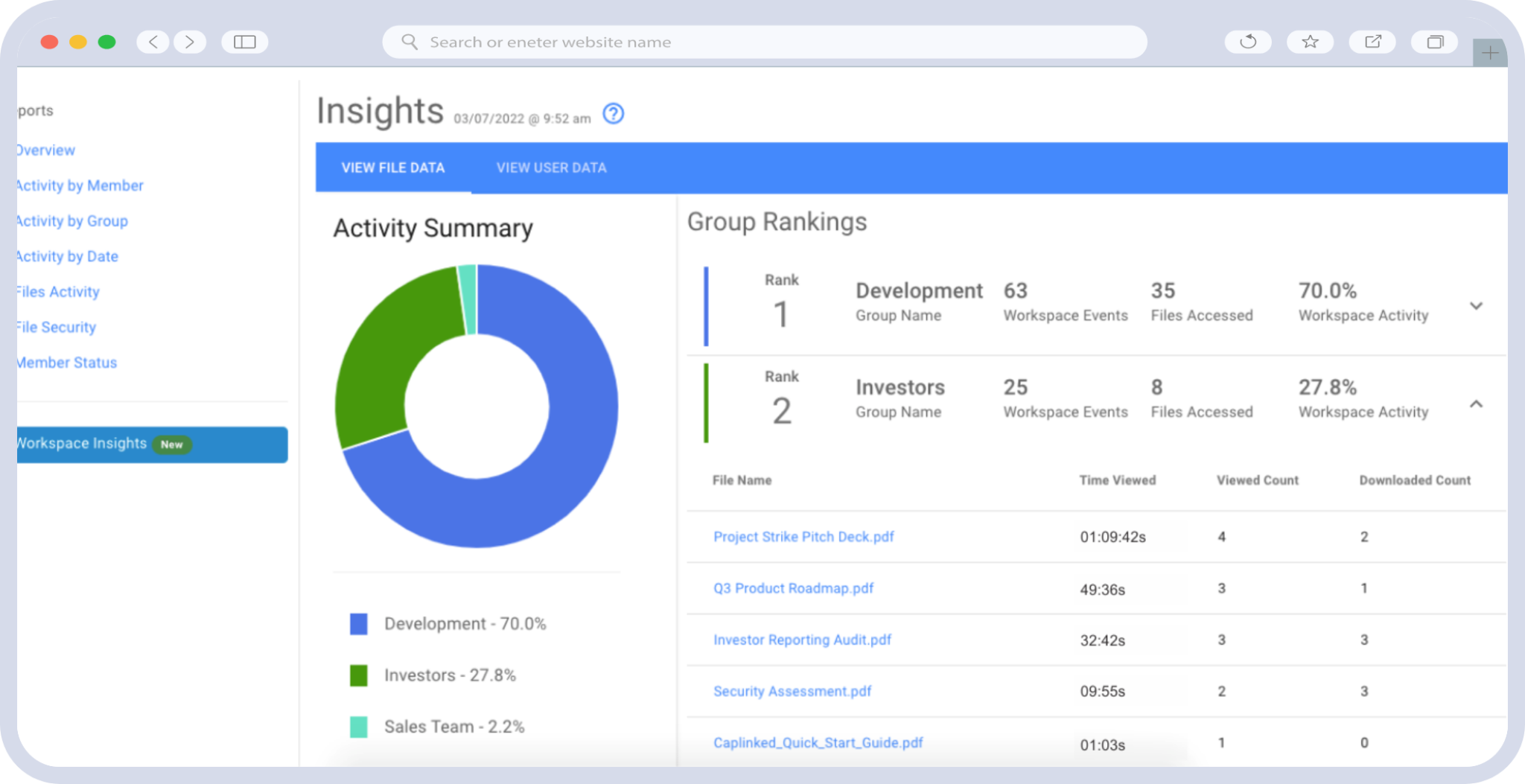Bankruptcy and restructuring are major undertakings that require careful planning and clear communication. Whether a company is reorganizing operations or managing creditor negotiations, large volumes of sensitive documents will change hands. Sharing these files by email attachments or outdated file-transfer systems can create confusion, security risks, and compliance gaps.
A Virtual Data Room (VDR) aims to tackle these challenges head-on. It provides a secure, centralized platform for storing and reviewing documents, helping key stakeholders—such as legal teams, creditors, and investors—collaborate with greater confidence. When used correctly, VDRs reduce administrative burdens and allow you to focus on what really matters: navigating your financial situation while protecting valuable assets and information.
Table of Contents
ToggleThe Complexities of Bankruptcy and Restructuring
Restructuring and bankruptcy often involve more moving parts than anticipated. Multiple parties need reliable access to real-time data, including critical financial and legal documents. Missing information or unauthorized file access can disrupt an already stressful process.
Multiple Stakeholders
Courts, creditors, investors, and internal teams might each require different sets of documents, and they may have different permission levels for review. Getting these materials to the right people—without risking sensitive details ending up in the wrong hands—can be difficult with outdated sharing methods.
Strict Timelines
Legal deadlines often come with little flexibility, so it’s essential to have a tight grip on your document flow. Failure to produce accurate records quickly could delay proceedings or even jeopardize the outcome of a case.
Ongoing Scrutiny
When a company is going through financial troubles, every detail can become subject to heightened oversight. That means data integrity and security need to be front and center. Even a small misstep, like misplacing a critical contract or disclosing information prematurely, can undermine trust among stakeholders.
A Virtual Data Room solves many of these challenges by providing a single, secure system that organizes your files and allows for granular user permissions. This approach not only streamlines your workflow but also makes it easier to show courts, creditors, and other stakeholders that you’re adhering to all requirements.
Why Document Security is Essential
During bankruptcy and restructuring, confidential information is often in play—financial records, legal pleadings, employee data, or strategic plans. If these details fall into the wrong hands, the consequences can be severe.
Protecting Sensitive Assets
In high-stakes financial dealings, leaks can damage reputations and potentially derail negotiations. A VDR minimizes these risks by using encryption and tiered access controls, so you have clarity over who can view, edit, or download files.
Regulatory Compliance
Bankruptcy and restructuring can attract regulatory attention, especially if there are concerns about financial transparency. Using a VDR helps you maintain compliance by generating audit logs that show exactly who accessed each document, when they accessed it, and whether they made any changes.
Peace of Mind for Stakeholders
Creditors, trustees, or potential investors often view rigorous document security as a sign of credibility. When they see you’re taking the right measures to protect important assets, they may be more inclined to cooperate, negotiate fairly, or invest in a restructured company.
From controlling who sees sensitive information to tracking user activity, Virtual Data Rooms offer a level of security that surpasses most traditional file-sharing methods. They help you stay on solid ground legally, financially, and in terms of stakeholder confidence—key ingredients for any successful bankruptcy or restructuring plan.
How VDRs Streamline Bankruptcy and Restructuring
A Virtual Data Room isn’t just an extra layer of security—it’s a platform that makes information management and collaboration easier when deadlines are tight and stakes are high.
Centralized Document Storage
All relevant records—financial statements, legal filings, employee agreements, or strategic plans—are accessible in one organized environment. This single source of truth ensures everyone references the right files at the right time, reducing errors that can stall negotiations.
Role-Based Access
In many cases, certain parties need to see only select portions of your data. A VDR allows you to assign permissions so you can precisely control who views, edits, or downloads each file. This level of detail helps protect confidential or privileged information.
Real-Time Updates and Alerts
When an important document is uploaded or updated, the relevant stakeholders receive notifications. This proactive approach helps you avoid time-wasting chases and keeps the process on schedule. It also provides a paper trail that demonstrates compliance with court-mandated timelines or creditor expectations.
Audit Logs for Transparency
If a creditor or trustee questions the process, your VDR’s audit logs show exactly who accessed which file and when. This record can clarify disputes or confirm that rules have been followed—both key concerns in bankruptcy proceedings.
Best Practices for Using a VDR in Bankruptcy and Restructuring
Even the most robust software can fall short without a clear plan. To get the most out of your Virtual Data Room, consider a few proven strategies.
1. Organize Files by Category
Set up folder structures that match your project’s natural workflow—e.g., legal, financial, HR. Clear labeling helps new users find what they need quickly, whether they’re internal staff or external advisors.
2. Keep Permissions Up to Date
Roles might shift as your bankruptcy or restructuring unfolds. Periodically review who has access to what, especially if an individual leaves the team or an outside firm completes its role. This habit locks down files that no longer need broad viewing rights.
3. Maintain Version Control
When multiple people are editing the same document, it’s easy to lose track of final versions. A well-configured VDR allows you to keep older iterations on file while directing users to the newest draft, minimizing confusion and rework.
4. Train Your Stakeholders
Not everyone is familiar with the idea of a VDR. A brief tutorial or cheat sheet can help external participants quickly adapt to the platform. This small investment of time upfront pays off by cutting down on mistakes and back-and-forth questions later.
By embracing these practices, you can transform a complex, document-heavy process into a more streamlined operation. It also helps ensure the security and privacy of the information at hand, fostering trust among creditors, courts, and other key players in your bankruptcy or restructuring journey.
How Caplinked Simplifies the Process
Even if you recognize the need for a Virtual Data Room, you might wonder how to pick the right one. Caplinked offers a streamlined experience designed for high-stakes transactions like bankruptcy and restructuring.
1. Intuitive User Interface
Your legal teams, creditors, and external consultants can quickly adapt. Minimal training is needed, allowing everyone to focus on the actual negotiation or review rather than learning a complicated tool.
2. Robust Security Measures
With features like multi-factor authentication and granular permissions, Caplinked helps lock down sensitive documents. Detailed audit logs record each action, providing a transparent history for all stakeholders.
3. Real-Time Monitoring and Alerts
Administrators can track user activity and set up notifications for uploads, updates, or downloads. This real-time insight helps keep the process moving smoothly while giving you the oversight you need.
4. Scalability for Changing Needs
Bankruptcy proceedings can grow more complex over time. Caplinked scales right along with those requirements, whether it’s adding more users or storing larger sets of documents. That adaptability prevents last-minute scrambling if the scope of your project evolves.
Navigate Restructuring and Bankruptcy More Easily With a Modern VDR From Caplinked
Bankruptcy and restructuring can be emotionally taxing and administratively complex, but the right technology helps you stay organized and compliant every step of the way. With a secure Virtual Data Room, you can centralize your documents, control access, and provide real-time transparency to the parties who need it most. Platforms like Caplinked take these benefits further by offering an intuitive interface and robust security measures that adapt to your evolving situation.
By implementing best practices—such as defining clear folder structures, regularly reviewing permissions, and training participants on how to use the VDR—you put yourself in a stronger position to navigate these challenging proceedings. Ultimately, a well-managed data-sharing environment can reduce friction, protect sensitive information, and foster a smoother path toward financial resolution.

